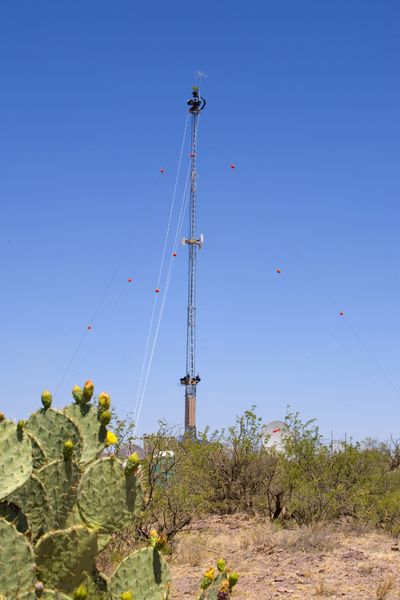‘Virtual’ fence on shaky ground
Boeing hoping to revive high-tech border program

CHICAGO – Along the boundary between Arizona and Mexico recently, Border Patrol agent Michael Scioli weaved his SUV through unforgiving rock formations and hills of desert brush. Illegal immigrants were covertly crossing the border nearby, but Scioli’s agency doesn’t always have the manpower to know exactly where.
Scioli then passed a 98-foot-tall tower fitted with cameras, a high-tech extra set of eyes that he and other agents presumably would welcome. “Don’t have much to say about that,” the agent said tersely.
The tower is part of a network of cameras and sensors rolled out with great fanfare by Chicago-based Boeing Co. three years ago but now largely disowned by Border Patrol agents and lambasted by lawmakers and government watchdogs.
The so-called virtual fence, which has received $500 million from the Department of Homeland Security, should have been fully in place already in southern Arizona. Instead, the department scrapped the first attempt, which cost Boeing at least $40 million in overruns.
Now, Boeing is trying to revive the troubled project after the U.S. government gave the company a second chance this month.
Homeland Security officials say technology is a necessary tool to track not only illegal immigrants but also violent Mexican drug smugglers and even potential terrorist threats.
At a hearing this month, Boeing tried to reassure skeptical lawmakers of progress in fixing glitches.
“I am amazed that we have spent (this much) and don’t have a system that works,” Rep. Sheila Jackson-Lee, D-Texas, told Boeing and government representatives at the hearing. “America is screaming for the right kind of security.”
The U.S. government has spent $3.7 billion on border improvements, including fencing and additional personnel, since fiscal 2005.
The government has more than doubled the number of Border Patrol agents, to about 20,000, and built about 600 miles of fencing along the southern border since 2006. But Homeland Security officials say technology is vital because of the harsh terrain.
Boeing won a contract in 2006 for the Secure Border Initiative and so far has received more than $500 million to implement a network of cameras, sensors and radar that has been plagued by glitches, according to the Government Accountability Office, the investigative arm of Congress.
Flash rainstorms would trip the radar accidentally. Satellite communications took too long to transmit instructions from cameras to control centers to agents in the field. By the time the agents reached locations minutes later where the cameras had registered a hit, the illegal immigrants had moved on.
With Boeing’s three-year technology contract set to expire in September amid few results, the Department of Homeland Security went back to the drawing board. To the surprise of some lawmakers, the government this month exercised a one-year contract option with Boeing.
Mark Borkowski, the Homeland Security official who directs the Secure Border Initiative, said that “the milk is spilled” and that it would have been too difficult and costly to start over with a new firm. He said the government would not have renewed the contract if it thought Boeing was “hopeless.”
“Saying it isn’t hopeless isn’t exactly high praise. It is more than that,” Borkowski said in a telephone interview. “Boeing hasn’t necessarily distinguished itself, but they are improving. They are on an upward trend.”
The network of cameras and sensors was scheduled to be fully operational by this year. Now, the government’s new projection for full operation has been pushed back to 2016.